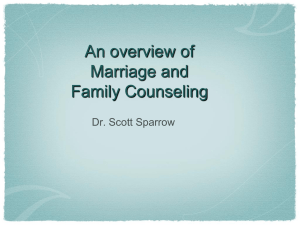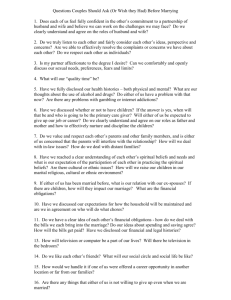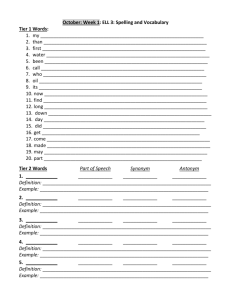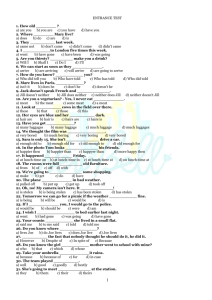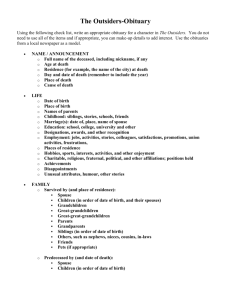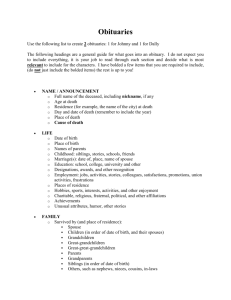In-laws
advertisement
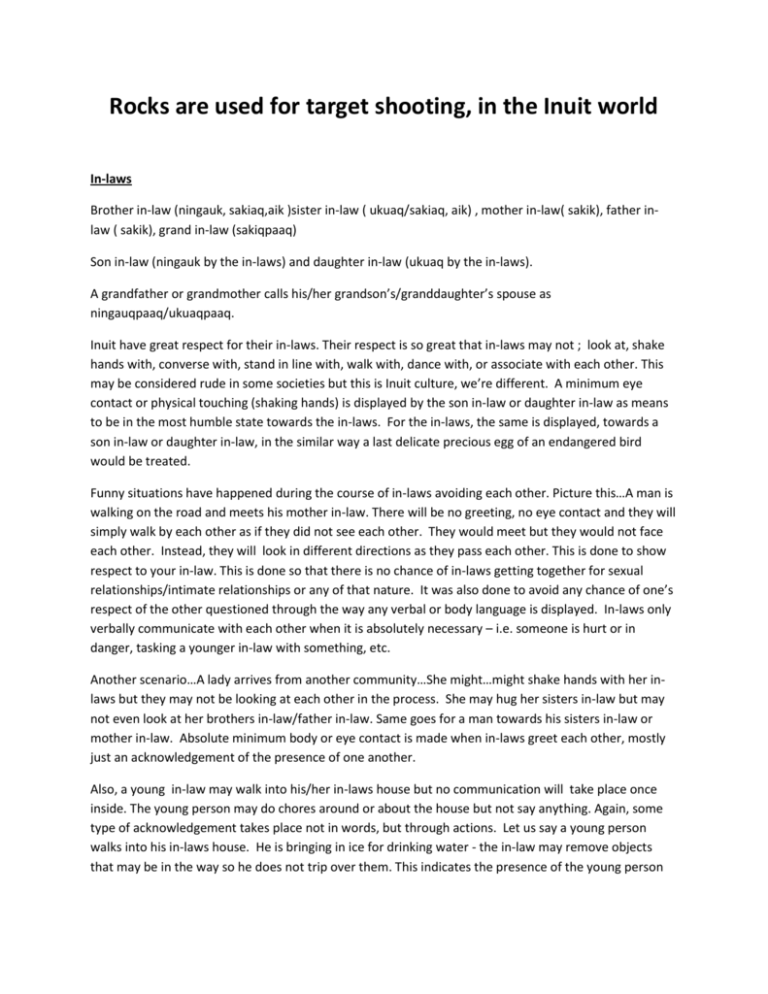
Rocks are used for target shooting, in the Inuit world In-laws Brother in-law (ningauk, sakiaq,aik )sister in-law ( ukuaq/sakiaq, aik) , mother in-law( sakik), father inlaw ( sakik), grand in-law (sakiqpaaq) Son in-law (ningauk by the in-laws) and daughter in-law (ukuaq by the in-laws). A grandfather or grandmother calls his/her grandson’s/granddaughter’s spouse as ningauqpaaq/ukuaqpaaq. Inuit have great respect for their in-laws. Their respect is so great that in-laws may not ; look at, shake hands with, converse with, stand in line with, walk with, dance with, or associate with each other. This may be considered rude in some societies but this is Inuit culture, we’re different. A minimum eye contact or physical touching (shaking hands) is displayed by the son in-law or daughter in-law as means to be in the most humble state towards the in-laws. For the in-laws, the same is displayed, towards a son in-law or daughter in-law, in the similar way a last delicate precious egg of an endangered bird would be treated. Funny situations have happened during the course of in-laws avoiding each other. Picture this…A man is walking on the road and meets his mother in-law. There will be no greeting, no eye contact and they will simply walk by each other as if they did not see each other. They would meet but they would not face each other. Instead, they will look in different directions as they pass each other. This is done to show respect to your in-law. This is done so that there is no chance of in-laws getting together for sexual relationships/intimate relationships or any of that nature. It was also done to avoid any chance of one’s respect of the other questioned through the way any verbal or body language is displayed. In-laws only verbally communicate with each other when it is absolutely necessary – i.e. someone is hurt or in danger, tasking a younger in-law with something, etc. Another scenario…A lady arrives from another community…She might…might shake hands with her inlaws but they may not be looking at each other in the process. She may hug her sisters in-law but may not even look at her brothers in-law/father in-law. Same goes for a man towards his sisters in-law or mother in-law. Absolute minimum body or eye contact is made when in-laws greet each other, mostly just an acknowledgement of the presence of one another. Also, a young in-law may walk into his/her in-laws house but no communication will take place once inside. The young person may do chores around or about the house but not say anything. Again, some type of acknowledgement takes place not in words, but through actions. Let us say a young person walks into his in-laws house. He is bringing in ice for drinking water - the in-law may remove objects that may be in the way so he does not trip over them. This indicates the presence of the young person as well as support on what is happening. All this without oral communication, and yet they are on the same page. A father/mother in-law may communicate important things/urgent matters directly to their brother/sister in-law but only when it is necessary. In-laws may talk about children’s safety directly but not for day-to-day matters. Scenario…a father in-law may indicate that his daughter is going to the store and asks if anybody else needs a ride, knowing very well that his daughter in-law needs a ride. The father in-law may not receive a verbal response from his daughter in-law but the daughter in-law would start for the door to get a ride with her sister in-law. This again is communication but not direct. The adult in-laws are respected a great deal by the young in-laws and likewise, the young ones are respected like their own sister or brother. Young people just married will become one of the family by joining the younger ones as brother/sister. This is expected, in fact … desired for a healthy and strong family ties. Those without biological brothers or sisters, get “new brother or sister “ when the new inlaws became part of the family. Again, this is expected. The parents in-law are the third parents of the new daughter/son in-law. The grandfathers/grandmothers in-law are fully in charge over the in-laws while they are alive. When young people get in-laws for the first time, the young lady would normally move in with the man’s family. Instantly becoming like a sister to her new sisters/brothers in-law. In the same process, becoming the “daughter” of the parents in-law. Also, a new son in-law is expected to move in with his new parents in-laws if they do not have a son to hunt for them. Again, instantly becoming the “Son”. Today, a young man/woman will join a family depending on the room available in the dwelling. Young people are expected to treat their new family as their own. When a family gets a new sister inlaw/brother in-law, she/he is expected to become part of the family. Becoming part of a family, for a young person, through marriage means sharing food, chores, good/ bad times, happy/sad times of the new family. (This will happen even if the younger ones live in another house). People also avoid calling their in-laws by name. Generally, calling anyone, who is older than you by name was considered to be rude. A well mannered person would always call all those who are older than him/herself by relations. For example, my uncle, so and so’s cousin/uncle/father/father in-law, etc… Peers tend to tease a younger person and try to get them to say the name of their in-laws. In some cultures, this would be very rude but it is used to build character. This was a way to test the breaking point of one’s tolerance to teasing. People build character by teasing them to a point where they will get slightly agitated but not out rightly angry. If a person can control his/her anger, things can run much smoother in life. Of course some people get carried away and may over- tease. This is not acceptable in the Inuit world, nor anywhere else. Teasing to a certain degree is acceptable for character building. A new brother in-law may not say/pronounce the name of his father/mother in-laws to show respect. The same person will not call his grands in-law by name, again to show respect. Rather, they will say something like this…”Your father/mother” ( when you are speaking to your brother in-law about their parents).Or, my “sakik”, my parent in-law. It goes the same for the grand in-laws…sakiqpaaq…They are the parents of your “in-laws”, so you call them “Sakiqpaaq”. ( Rank: The highest ranking in-laws). Gender Women tend to speak more freely with their female relatives, whereas a man tends to mingle with his male relatives more freely. You may see sisters in-law acting like sisters. This is desired. Brothers in-law do the same. This too is desirable. A young person usually communicates his/her intentions through her/his sister/brother in-law since they are more at their level whereas the mothers/fathers in-law hold more stakes and tend to be more like” grown” person. A sister/brother in-law may work as a “middle” person. i.e. a new daughter in-law needs a new amauti… The new member usually does not communicate directly to her in-laws but rather uses her sister/brother in-law/husband to communicate with the in-laws for her. The next thing you know is that the mother in-law is working on an amuti for her. I’m not sure where this story comes from but it goes something like this… A woman is in labor. She tells her husband to go and tell her mother that she is in labor. The man walks into his in-laws but sees only his mother in-law and a puppy. Looking at the puppy, says that his wife is in labor and leaves. Right away the mother rushes out of the house to tend to her daughter. Even though the man did not communicate directly to his mother in-law, the message was still received. This is how we used to communicate with our in-laws. Now a days, most people talk to their in-laws, but they will not be as open as they would if they were talking to someone younger, like a sister/brother in-law. A lady has a brother in-law by the name of “Nasaq” (Hat). She would go through great lengths to avoid using the word “hat” when referring to a hat. Instead of using the word “hat” outright, she would describe the object in a way it is understandable to the listener, i.e. “head clothing”. When it is necessary to refer to her brother in-law “Nasaq”, she would refer to him as her “brother in-law” and would further describe him by adding “your oldest brother, little Billy’s dad, etc. but she is not suppose to say the name as it is the custom. When she talked to a friend, she mentions that person but by the meaning of the word only… “The person with a head clothing”. “Nasaq” was never mentioned but the other party understood. One more thing about parents in-law. Even though in-laws don’t speak freely to each other, they have great respect. Inuit everywhere do not make fun of their in-laws. They do not talk negatively, or make unnecessary comments towards their in-laws. Instead, you will hear something positive like … “ My father in-law just bought me some gas!” Or “My mother in-law made me a new pair of mittens!” Young people marrying into a family are expected to become part of the family. Most Inuit do not talk negatively about their parents, so it goes the same way for the in-laws. Inuit have great respect for their in-laws, and they should. Elijah Tigullaraq September 2009
